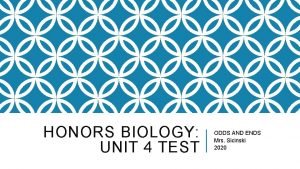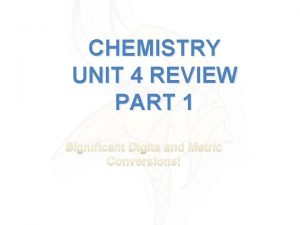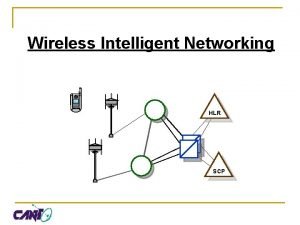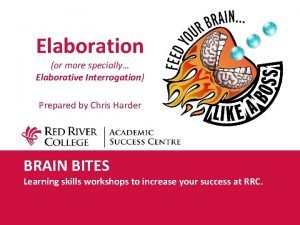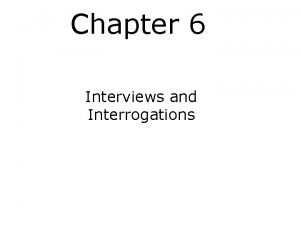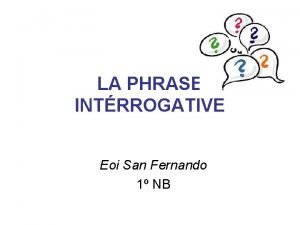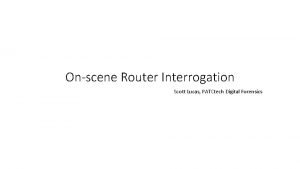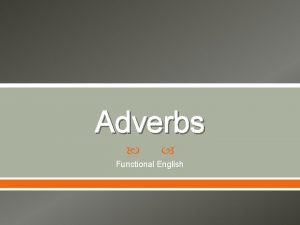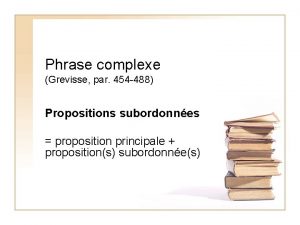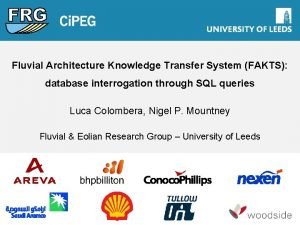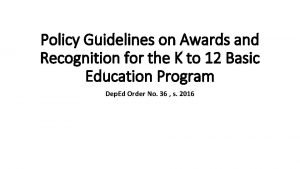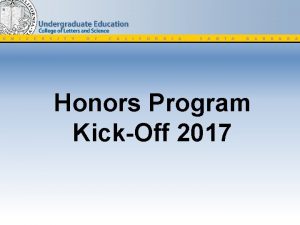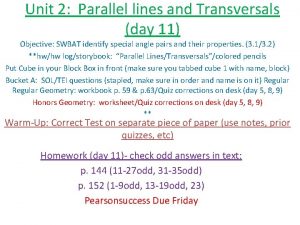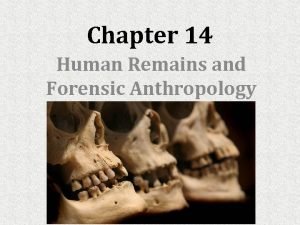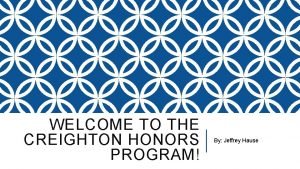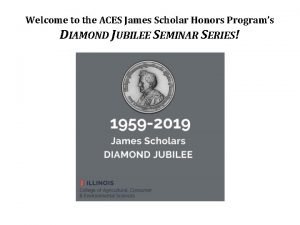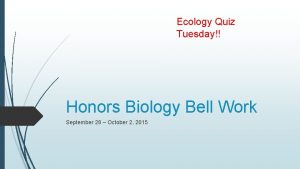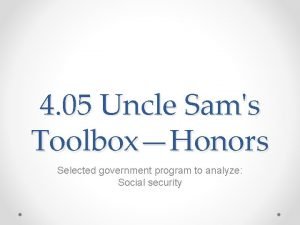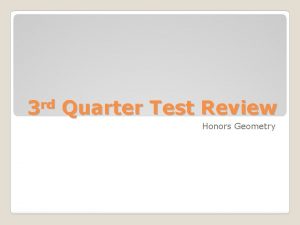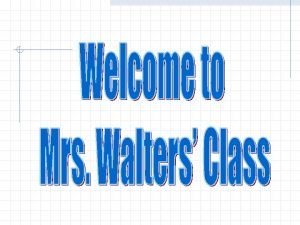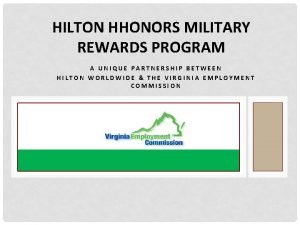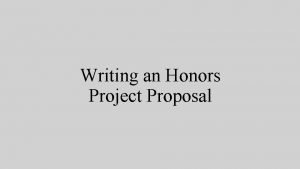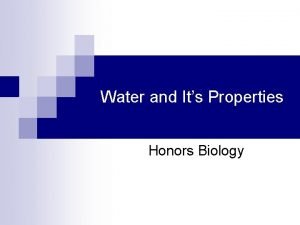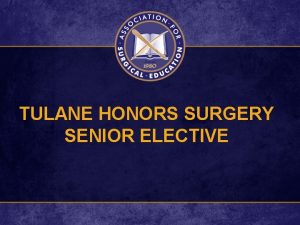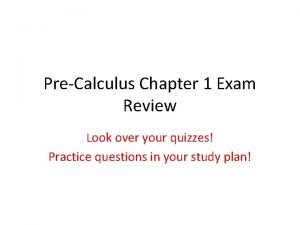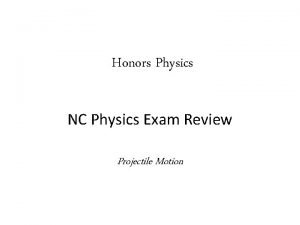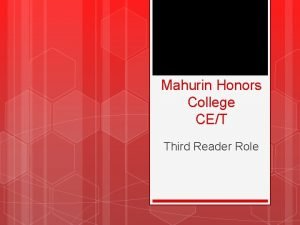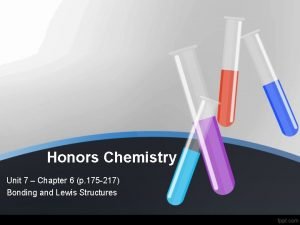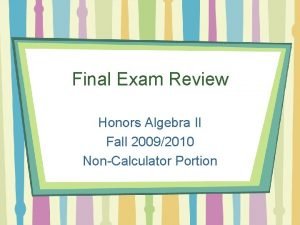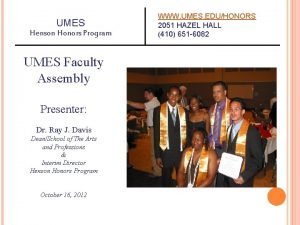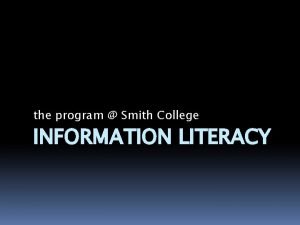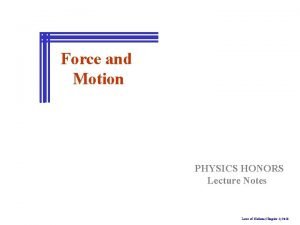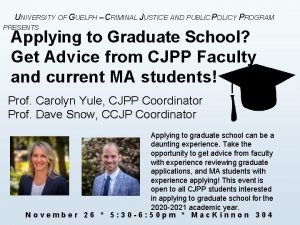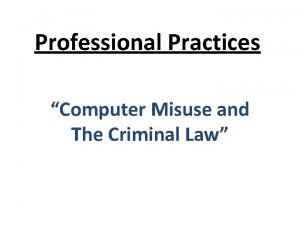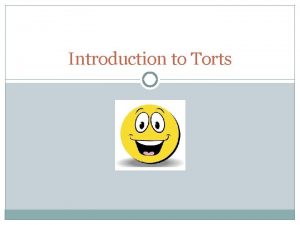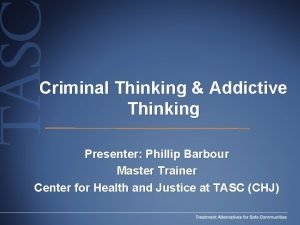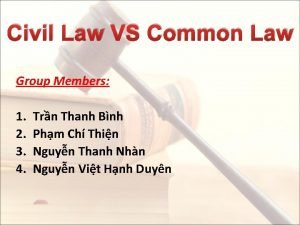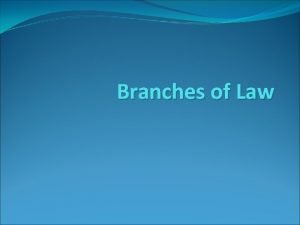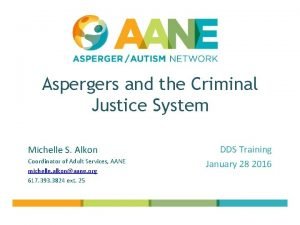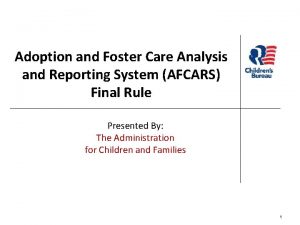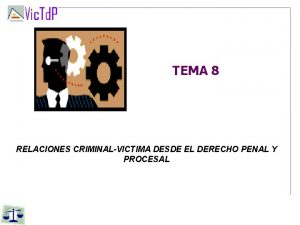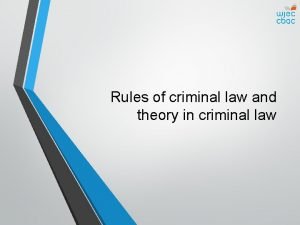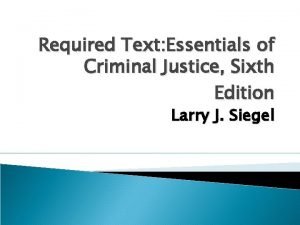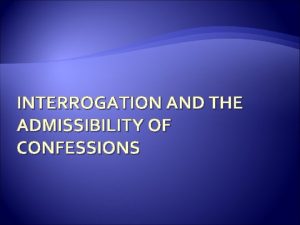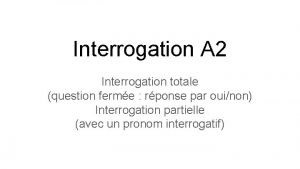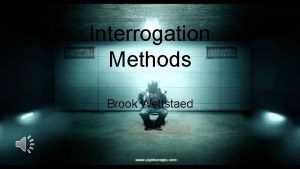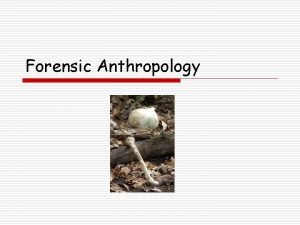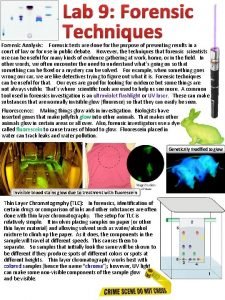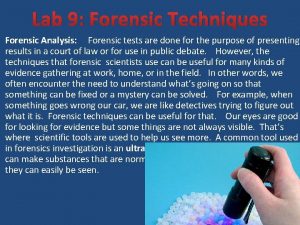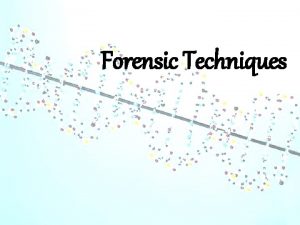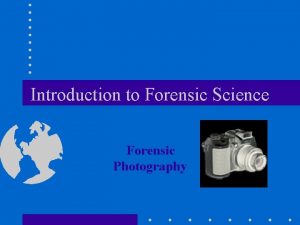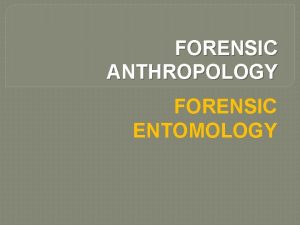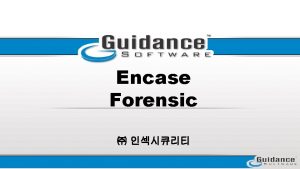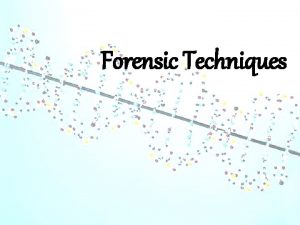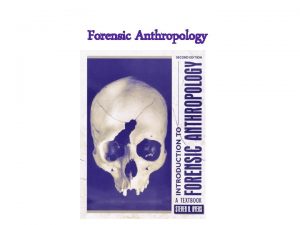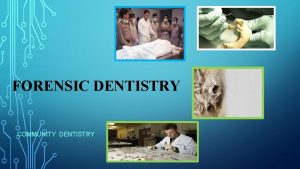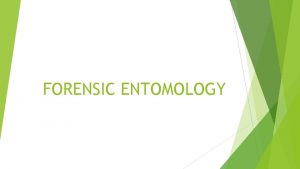Honors Unit 2 Interrogation and Forensic Reporting Criminal



































































- Slides: 67

Honors Unit 2 Interrogation and Forensic Reporting & Criminal Profiling © 2012 Cengage Learning. All Rights Reserved

What is Required: o Turn entire unit in by April 21 st in a folder for grading: • • • o o o 2 o All assignments must be completed Notes taken Expert Testimony on ONE of the cases/labs Movie on Profiling by April 25 th Test on Unit by April 25 th Good Luck & Please ask if you have questions jerickson@neacademy. net Forensic Science II: Interrogation and Forensic Reporting, Chapter 2 & 15 © 2012 Cengage Learning. All Rights Reserved

Introduction—Objectives 1. Identify important events in the history of law enforcement. 2. Explain J. Edgar Hoover’s contributions to the formation of the FBI. 3. Evaluate the importance of a code of ethics to professional organizations. 4. Compare and contrast an interview and an interrogation. 3 Forensic Science II: Interrogation and Forensic Reporting, Chapter 2 © 2012 Cengage Learning. All Rights Reserved

Introduction—Objectives 5. Describe the cognitive approach for interviewing. 6. Discuss special considerations for interviewing children. 7. Differentiate between the fi ve common models of interrogation. 8. Explain the importance of objectivity in report writing. 4 Forensic Science II: Interrogation and Forensic Reporting, Chapter 2 © 2012 Cengage Learning. All Rights Reserved

Introduction—Objectives 9. 10. 11. 12. 13. 5 List key contributors to and their work in the field of criminal profiling. Explain the stages of the criminal profiling process. Assess the importance of victimology in the criminal profiling process. Differentiate between the roles of the investigator and the profiler. Explain the value of developing a victim’s timeline. Forensic Science II: Interrogation and Forensic Reporting, Chapter 2 © 2012 Cengage Learning. All Rights Reserved

Introduction—Vocabulary o o o 6 ethics - a set of rules that define appropriate behavior in a situation interrogation - official questioning of a suspect or witness by law enforcement interview - a question and answer session that does not accuse but is instead intended to gather information concerning a case and/or a suspect Forensic Science II: Interrogation and Forensic Reporting, Chapter 2 © 2012 Cengage Learning. All Rights Reserved

Introduction—Vocabulary o o o 7 interviewer - a trained individual who questions witnesses or suspects and is able to interpret cues in verbal and physical behavior objectivity - judgment that is not influenced by personal feelings or bias, focused on fact suspect - an individual under investigation for his or her alleged involvement in a crime Forensic Science II: Interrogation and Forensic Reporting, Chapter 2 © 2012 Cengage Learning. All Rights Reserved

Introduction—Vocabulary o o 8 Criminal profiler—a person who infers the personality and characteristics of a suspect based on information gathered from a crime scene Modus operandi (MO)—also referred to as the method of operation, a recognized pattern of behavior in the commission of a crime Forensic Science II: Interrogation and Forensic Reporting, Chapter 2 © 2012 Cengage Learning. All Rights Reserved

Introduction—Vocabulary o o o 9 Signature—something unusual or specific left at the crime scene by the perpetrator Victim—person who has experienced harm, injuries, loss, or death Victimology—the study of victims affected by crime, accidents, or natural disasters Forensic Science II: Interrogation and Forensic Reporting, Chapter 2 © 2012 Cengage Learning. All Rights Reserved

Case: The Last Drive o o o 10 Read the case about Susan Smith from October 24, 1994 Summarize what happened. What happened in her interrogation? How did the local sheriff and the FBI work together? What was the end result? Forensic Science II: Interrogation and Forensic Reporting, Chapter 2 Forensic Science Learning. II: Title, Chapter # Reserved © 2012 Cengage All Rights

Notes: Historical Development (Obj 2. 1, 2. 2) o England • • • 11 1115 — The Laws of Henry I outlined the legal customs during that reign 1748 — the first magistrate appointed to prosecute criminals 1829 — Peel introduced the Metropolitan Police Act, creating the first modern police force Forensic Science II: Interrogation and Forensic Reporting, Chapter 2 © 2012 Cengage Learning. All Rights Reserved

Notes: Historical Development (Obj 2. 1, 2. 2) o The United States • • 1790 — NY City has a fully operational daytime paid police force U. S. Department of Justice • • 12 Attorney General position created by the U. S. constitution 1908 — the DOJ organizes a group of 34 special agents and called the Bureau of Investigation Forensic Science II: Interrogation and Forensic Reporting, Chapter 2 © 2012 Cengage Learning. All Rights Reserved

Notes: Historical Development (Obj 2. 1, 2. 2) o The United States (cont. ) • Edgar J. Hoover • • 13 Established new professional standards for employment and promotion in the Bureau 1924 — created central storage for fingerprints 1932 — created a crime lab 1935 — name changed to the FBI Forensic Science II: Interrogation and Forensic Reporting, Chapter 2 © 2012 Cengage Learning. All Rights Reserved

Notes: Ethics (Obj 2. 3) o o 14 Ethics is a set of guidelines— written and unwritten—that explain appropriate conduct for a particular situation or profession. A written code of ethics describes a process for enforcing appropriate conduct by a profession’s members and usually establishes a system for the investigation and resolution of alleged unethical conduct. Forensic Science II: Interrogation and Forensic Reporting, Chapter 2 © 2012 Cengage Learning. All Rights Reserved

Notes: Ethics (Obj 2. 3) The American Academy of Forensic Sciences (AAFS) 15 Forensic Science II: Interrogation and Forensic Reporting, Chapter 2 © 2012 Cengage Learning. All Rights Reserved

Questions: Ethics (research needed) 1. 2. 3. 16 Identify ways in which trial lawyers connect with the jury and respect the courtroom. Explain why it is ethically significant for a trial lawyer to refrain from providing an opinion in the courtroom. Do you think that the “likeability” of an attorney can carry as much weight with a jury as the lawyer’s presentation of the facts can? Explain. Forensic Science II: Interrogation and Forensic Reporting, Chapter 2 © 2012 Cengage Learning. All Rights Reserved

Ethics Paper (1 page) o Requirements • • 17 Research a case where Ethics were in question. What was the result of the case? Did the result have to do Ethics issue? Typed, font 12, times new roman, double spaced. Forensic Science II: Interrogation and Forensic Reporting, Chapter 2 © 2012 Cengage Learning. All Rights Reserved

Notes: Bias (Obj 2. 3) o o o 18 Criminal investigations must try to avoid bias Minimize preconceived notions about any aspect of the case - such as victim or suspect Bias can affect the evaluation Forensic Science II: Interrogation and Forensic Reporting, Chapter 2 © 2012 Cengage Learning. All Rights Reserved

Notes: Miranda Warning You have the right to remain silent Anything you say can and will be used against you in a court of law. 3. You have the right to talk to a lawyer and have him present with you while you are being questioned. 4. If you cannot afford to hire a lawyer, one will be appointed to represent you before any questioning if you wish. 5. You can decide at any time to exercise these rights and not answer any questions or make any statement WAIVER: Do you understand each of these rights I have explained to you? Having these rights in mind, do you wish to talk to us now? 1. 2. 19 Forensic Science II: Interrogation and Forensic Reporting, Chapter 2 © 2012 Cengage Learning. All Rights Reserved

U. S. Supreme Court case of Miranda v. Arizona; 1966 o o o 20 What amendment was not upheld? Scenario: Dan is arrested and, without being read his Miranda rights, is questioned by police officers about a bank robbery. Dan confesses to committing the robbery and tells the police that the money is buried in his backyard. Acting on this information, the police dig up the money. Dan's attorney challenges the confession in court, what will the judge determine? Why? Forensic Science II: Interrogation and Forensic Reporting, Chapter 2 © 2012 Cengage Learning. All Rights Reserved

Notes: Interviewing Techniques (Obj 2. 4, 2. 5, 2. 6) 21 Forensic Science II: Interrogation and Forensic Reporting, Chapter 2 © 2012 Cengage Learning. All Rights Reserved

Notes: Interviewing Techniques (Obj 2. 4, 2. 5, 2. 6) Interviewing Children o Make the child feel as safe and comfortable as possible o Techniques vary depending upon age and the nature of the crime o Questions are prepared in advance o The setting is in a private location o The interview is usually videotaped 22 Forensic Science II: Interrogation and Forensic Reporting, Chapter 2 © 2012 Cengage Learning. All Rights Reserved

Notes: Interviewing Techniques (Obj 2. 4, 2. 5, 2. 6) Children in the Courtroom o Children are naturally very truthful o Make sure the child understand the responsibilities of being a witness o The judge must consider the emotional impact on the child o Should the child face the alleged perpetrator? 23 Forensic Science II: Interrogation and Forensic Reporting, Chapter 2 © 2012 Cengage Learning. All Rights Reserved

Notes: Interrogation—Preparing o Review all documentation • • o 24 Witness statement Police reports Physical evidence collected Laboratory reports Follow established guidelines Forensic Science II: Interrogation and Forensic Reporting, Chapter 2 © 2012 Cengage Learning. All Rights Reserved

Notes: Interrogation—Physical Setting o o o 25 Privacy Soundproof room Minimal furniture Speaker system Mirror/Glass for observation Forensic Science II: Interrogation and Forensic Reporting, Chapter 2 © 2012 Cengage Learning. All Rights Reserved

Notes: Interrogation—Organizing o Interviewer • • 26 Establishes control Explains the suspect’s 5 th & 6 th amendment rights Shows evidence to support the case Body language is very deliberate Forensic Science II: Interrogation and Forensic Reporting, Chapter 2 © 2012 Cengage Learning. All Rights Reserved

Notes: Interrogation—Models 27 Forensic Science II: Interrogation and Forensic Reporting, Chapter 2 © 2012 Cengage Learning. All Rights Reserved

Notes: Signs of Deception o A combination of behaviors • • • 28 Eye and mouth movements Not looking directly into the interviewer’s eyes Arms crossed Cover the mouth Shifting position abruptly Forensic Science II: Interrogation and Forensic Reporting, Chapter 2 © 2012 Cengage Learning. All Rights Reserved

Assignment: Paragraph on Jon. Benet Ramsey & John Mark Karr o 29 Forensic Science II: Interrogation and Forensic Reporting, Chapter 2 © 2012 Cengage Learning. All Rights Reserved In 2006, John Mark Karr confessed to the murder of Jon. Benet Ramsey. In one paragraph explain why the FBI knew he did not commit the crime.

Polygraph Questions o o o 30 What does a polygraph measure? List 4. Are polygraphs 100% correct? Why? How can you beat a polygraph? Forensic Science II: Interrogation and Forensic Reporting, Chapter 2 © 2012 Cengage Learning. All Rights Reserved

Notes: Reporting Information o o 31 Be accurate Be truthful Be objective Be comprehensive Forensic Science II: Interrogation and Forensic Reporting, Chapter 2 © 2012 Cengage Learning. All Rights Reserved

Chapter Summary o o o As cities grew, the focus of policing shifted from peace-keeping to crime prevention. The U. S. Department of Justice initially relied on outside organizations to perform investigations. J. Edgar Hoover, director of the Bureau of Investigation, • • • 32 set standards for employment and promotion, consolidated the fingerprint databases, and created a crime lab to help federal, state, and local agencies process and analyze evidence. Forensic Science II: Interrogation and Forensic Reporting, Chapter 2 © 2012 Cengage Learning. All Rights Reserved

Chapter Summary o o 33 A code of ethics is a set of guidelines for appropriate behavior as well as a system to enforce professional conduct. During an interview, an investigator asks questions designed to gather information. During an interrogation, the investigator expects to gather incriminating statements or a confession. The most common interview technique is the cognitive approach, which enhances recollection of information. Forensic Science II: Interrogation and Forensic Reporting, Chapter 2 © 2012 Cengage Learning. All Rights Reserved

Chapter Summary o o 34 Special considerations are always given when interviewing children, but the ultimate goal is to obtain the truth. The five common models of interrogation are suspect decision-making, cognitive-behavioral, psychoanalytical, emotional, and interaction process. Accurate, truthful, and objective reporting is essential to maintaining professionalism standards. Objectivity is a focus on facts without influence from opinion or bias. Forensic Science II: Interrogation and Forensic Reporting, Chapter 2 © 2012 Cengage Learning. All Rights Reserved

Activity: Crime Scene; Sibling Rivalry o o o 35 Read Case Answer follow up questions After reading the story, write your own story in which someone is falsely accused of a crime. Be sure that any interviews or interrogations within your story follow at least one of the models described in the chapter. Your story should be 800 words or less. Forensic Science II: Interrogation and Forensic Reporting, Chapter 2 © 2012 Cengage Learning. All Rights Reserved

Activities: 2 -1 & 2 -2 o o 36 Activity 2 -1: Drive. By Shooting You can work with a partner. Forensic Science II: Interrogation and Forensic Reporting, Chapter 2 © 2012 Cengage Learning. All Rights Reserved o o o Activity 2 -2: Ethical Errors Must work individually Choose any ONE case

Chapter Review and Case Studies o o 37 Read Case Study on Ruby Ridge and answer the think critically question. Read Case Study on John Stoll and answer the three think critically questions. Read Careers in Forensics Dr. Park Dietz: Forensic Psychiatrist Complete Chapter Review Forensic Science II: Interrogation and Forensic Reporting, Chapter 2 © 2012 Cengage Learning. All Rights Reserved

Case: Profiling a Serial Killer: Returning to the Scene of the Crime o o o 38 Read the case about Rochester, NY— 1989, multiple murders What was the role of Gregg Mc. Crary? Mc. Crary studied the murder’s MO, what did he conclude? Because of Mc. Crary’s conclusion what did the police do? Did it work? What was the outcome for Arthur Shawcross? Forensic Science II: Criminal Profiling, Chapter 15 © 2012 Cengage Learning. All Rights Reserved

Notes: Introduction o Criminal profilers study evidence collected analyzed by crime-scene investigators to formulate a hypothesis about a perpetrator’s • • 39 Age Personality Lifestyle Social environment Forensic Science II: Criminal Profiling, Chapter 15 © 2012 Cengage Learning. All Rights Reserved

Notes: History (Obj 15. 1, 15. 2) o o 40 Cesare Lobroso, The Criminal Man, 1876 Suggested that criminals shared certain characteristics Three general types Science has since disproved that physical attributes can predict behavior Forensic Science II: Criminal Profiling, Chapter 15 © 2012 Cengage Learning. All Rights Reserved

Notes: History o o o 41 Hans Gross, Criminal Investigation: A Practical Textbook for Magistrates, Police Officers, and Lawyers, 1906—use science, be systematic Gerald Fosbroke, Character Reading Through Analysis of the Features, 1914 (later disproved) Erich Wulffen, Woman as A Sexual Criminal, 1935 John O’Connell and Harry Soderman, Modern Criminal Investigation, 1930 s Paul Kirk, Criminal Investigation, 1953 Forensic Science II: Criminal Profiling, Chapter 15 © 2012 Cengage Learning. All Rights Reserved

Assignment: Profiling Witches o o 42 In 1486, during the Spanish Inquisition, a manual was written that was used to profile “witches. ” The profiles typically consisted of women who would cause some type of harm that risked the welfare of communities and children. The profiles where used to catch and prosecute the alleged witches by burning them at the stake. Create a profile of one of the “witches” burned at the stake in Salem, Massachusetts. (1 paragraph) Forensic Science II: Interrogation and Forensic Reporting, Chapter 2 © 2012 Cengage Learning. All Rights Reserved

Notes: Modern Day Profiling o Forensic psychiatrist • • o 43 Interviews criminals and suspects Evaluates personal history Administers personality tests Presents an opinion as testimony in court James Brussel, 1950 s, viewed profiling as a diagnostic tool, bridging the gap between criminal investigators and forensic psychiatrists Forensic Science II: Criminal Profiling, Chapter 15 © 2012 Cengage Learning. All Rights Reserved

Notes: Modern Day Profiling o o o 44 Howard Teten—created a criminal profiling division in 1970 for the FBI Jack Kirsh, an FBI agent, opened the FBI’s Behavioral Science Unit (BSU) BSU is now directed by the National Center for the Analysis of Violent Crime (NCAVC) Forensic Science II: Criminal Profiling, Chapter 15 © 2012 Cengage Learning. All Rights Reserved

Notes: Stages of the Profiling Process 1. 2. 3. 4. 5. 6. Input Decision process models Crime assessment Criminal profile Investigation Apprehension The logic is that the way a person thinks guides his or her behavior. 45 Forensic Science II: Criminal Profiling, Chapter 15 © 2012 Cengage Learning. All Rights Reserved

Notes: 1 – Input o Collecting evidence (for example) • • o History of the victim • • • o 46 Placement of the victim and weapon(s) Body position Blood splatter Condition of surroundings Employment and reputation Social habits Hobbies and interests Autopsy report Forensic Science II: Criminal Profiling, Chapter 15 © 2012 Cengage Learning. All Rights Reserved

Notes: 2 – Decision Process Models o o o 47 Classifying the crime Determining motives Risk level of the victim Forensic Science II: Criminal Profiling, Chapter 15 © 2012 Cengage Learning. All Rights Reserved

Notes: 3 – Crime Assessment o Motivation behind the crime • • o o 48 Premeditated and planned? Impulsive and no plan? Modus Operandi— the method of operation Signature—repeating a habit at each crime scene Forensic Science II: Criminal Profiling, Chapter 15 © 2012 Cengage Learning. All Rights Reserved

Notes: 4 – Criminal Profile o A typical profile includes estimates of: • • • o 49 Race Sex Physical characteristics Habits Values and beliefs Compare the profile with the decision process models (stage 2) and reconstruction of the crime scene Forensic Science II: Criminal Profiling, Chapter 15 © 2012 Cengage Learning. All Rights Reserved

Notes: 5 – Investigation o o 50 Begins after profiler submits written report Seek and evaluate suspects that match the profile Forensic Science II: Criminal Profiling, Chapter 15 © 2012 Cengage Learning. All Rights Reserved

Notes: 6 – Apprehension o o 51 Apprehend Interview Interrogate Arrest Forensic Science II: Criminal Profiling, Chapter 15 © 2012 Cengage Learning. All Rights Reserved

Profiling Assessment #1 o o o 52 Research the methods of evaluating and assessing various types of offenders. Write a 1 - to 2 -page summary of the interview techniques as well as the types of testing procedures that are used to ensure a thorough and accurate assessment. Be sure to address the problems associated with a hastily completed assessment Forensic Science II: Interrogation and Forensic Reporting, Chapter 2 © 2012 Cengage Learning. All Rights Reserved

Profiling Assessment #2 o o o 53 Watch an episode of Criminal Minds Write up a synopsis of the Profile given by the team to the local police department. How close was the profile to the actual criminal? What were they off on? Forensic Science II: Interrogation and Forensic Reporting, Chapter 2 © 2012 Cengage Learning. All Rights Reserved

Notes: Victimology (Obj 15. 4, 15. 5, 15. 6) o o 54 A victim is a person who has experienced harm, injuries, loss, or death. Victimology is the study victims who have been affected by crime, accidents, or natural disasters. Forensic Science II: Criminal Profiling, Chapter 15 © 2012 Cengage Learning. All Rights Reserved

Notes: Victim Risk o 55 Assessment is very subjective Forensic Science II: Criminal Profiling, Chapter 15 © 2012 Cengage Learning. All Rights Reserved

Notes: Victim Risk All risks are considered from the perspective of the victim’s age, job, and criminal background. o o o 56 Aggressive nature Impulsive Anxious Passive Thrives on attention Forensic Science II: Criminal Profiling, Chapter 15 © 2012 Cengage Learning. All Rights Reserved o o Self-inflicted injuries Poor self-image Negative Exhibits addictive behaviors

Notes: Victimology Assessment o At the crime scene • • • 57 Did the victim know the perpetrator? Does the victim suspect anyone in particular and why? Has the victim reported similar or other crimes in which he or she was the victim? Is the victim carrying a weapon? Does the victim own a weapon? Has the victim been in any other police reports in the past? Forensic Science II: Criminal Profiling, Chapter 15 © 2012 Cengage Learning. All Rights Reserved

Notes: Victimology Assessment o Forensics and profiling working together: • • 58 What are some of the victim’s general physical characteristics, including eye color, hair color, weight, and ethnicity? Where does the victim work and what is his or her work schedule? Does the victim have a criminal history? If so, investigators will ask the victim to explain. What is the victim’s daily routine? Forensic Science II: Criminal Profiling, Chapter 15 © 2012 Cengage Learning. All Rights Reserved

Notes: Victimology Assessment o Working together (cont’d): • • • o 59 What is the contact information of the victim’s family members, friends, and coworkers? What is the victim’s medical history, including mental health records? What medications is the victim taking? What is the victim’s education level? Where does the victim live and with whom? Create a timeline of events Forensic Science II: Criminal Profiling, Chapter 15 © 2012 Cengage Learning. All Rights Reserved

Create a Poster or Brochure o o o 60 Research how criminals study people to select the most vulnerable targets. Create a poster or brochure to educate others on how to protect themselves from becoming a crime victim. Include behaviors that criminals look for in their selection of targets and precautions that may be taken to lessen one’s probability of becoming a victim. Forensic Science II: Interrogation and Forensic Reporting, Chapter 2 © 2012 Cengage Learning. All Rights Reserved

Chapter Summary o o o 61 Criminal profilers estimate the characteristics and traits of a perpetrator to narrow the field of suspects. Criminal profiling dates back to the 1800 s when Cesare Lombroso concluded that there were three types of criminals. In 1972, Jack Kirsh opened the FBI’s Behavioral Science Unit and helped law enforcement solve cases by developing criminal profiles of unknown suspects. Forensic Science II: Criminal Profiling, Chapter 15 © 2012 Cengage Learning. All Rights Reserved

Chapter Summary o The criminal profiling process has 6 stages: • • • 62 input, decision process models, crime assessment, criminal profile, investigation, and apprehension Forensic Science II: Criminal Profiling, Chapter 15 © 2012 Cengage Learning. All Rights Reserved

Chapter Summary o o o 63 A victim is a person who has experienced harm, injuries, loss, or death. Victimology is the study victims who have been affected by crime, accidents, or natural disasters. By assessing a victim’s lifestyle, preferences, family, relationships, and routines, investigators may gather clues about potential suspects who had access to the victim. Forensic Science II: Criminal Profiling, Chapter 15 © 2012 Cengage Learning. All Rights Reserved

Chapter Summary o o o 64 The investigator collects and analyzes physical evidence, and The profiler makes inferences about the personality and characteristics of a suspect based on the evidence gathered. A timeline of the victim’s events helps investigators determine who had access to the victim. The 24 hours leading up to the crime yields the most helpful information. Forensic Science II: Criminal Profiling, Chapter 15 © 2012 Cengage Learning. All Rights Reserved

Activity: Crime Scene; Death at the Docks o o o 65 Read Case Answer follow up questions Rewrite the ending of this story to make one of the other suspects the criminal. Additional changes in the story may need to be made in order for a different criminal to work within the story. Be creative in your changes. Forensic Science II: Interrogation and Forensic Reporting, Chapter 2 © 2012 Cengage Learning. All Rights Reserved

Chapter Review and Case Studies o o 66 Read Case Study on New York’s Mad Bomber and answer the two think critically questions. Read Case Study on Atlanta Child Murders and answer the three think critically questions. Read Careers in Forensics Forensic Psychiatrist Complete Chapter Review Forensic Science II: Interrogation and Forensic Reporting, Chapter 2 © 2012 Cengage Learning. All Rights Reserved

Work Packet o o Slides to be copied: 2, 10, 16, 17, 20, 29, 30, 35, 36, 37, 38, 42, 53, 60, 65, & 66 Pages from text book: • • 67 Ch 2: 36, 51 -58, & 60 -65 Ch 15: 428, & 442 -449 Forensic Science II: Interrogation and Forensic Reporting, Chapter 2 © 2012 Cengage Learning. All Rights Reserved
 Pathologist and anthropologist
Pathologist and anthropologist Forensic psychiatry vs forensic psychology
Forensic psychiatry vs forensic psychology Honors biology unit 4 test
Honors biology unit 4 test Honors chemistry unit 4 review answers
Honors chemistry unit 4 review answers Golden opulence sundae
Golden opulence sundae Chapter 11 basic concepts street law
Chapter 11 basic concepts street law Scp wike
Scp wike Elaborative interrogation definition
Elaborative interrogation definition Face saving style of interrogation
Face saving style of interrogation Interrogation par intonation
Interrogation par intonation Good cop bad cop interrogation
Good cop bad cop interrogation Router forensics
Router forensics Adverb of interrogation
Adverb of interrogation Proposition subordonnée participiale
Proposition subordonnée participiale Wysol
Wysol Deped order no. 36, s. 2016
Deped order no. 36, s. 2016 Ucsb letters and science honors
Ucsb letters and science honors Honors geometry parallel lines and transversals worksheet
Honors geometry parallel lines and transversals worksheet Forensic science unit 1 review
Forensic science unit 1 review Pro corbis
Pro corbis Chapter 14 review forensic science
Chapter 14 review forensic science Creighton university honors program
Creighton university honors program James scholar program
James scholar program Honors physics semester 1 review
Honors physics semester 1 review Honors biology ecology test
Honors biology ecology test 4.05 economics uncle sam's toolbox
4.05 economics uncle sam's toolbox Honors geometry quadrilaterals test
Honors geometry quadrilaterals test Honors earth science
Honors earth science Kuei honors chemistry
Kuei honors chemistry Mrs blueprint
Mrs blueprint Hilton honors military program
Hilton honors military program Honors project
Honors project Honors biology properties of water lab
Honors biology properties of water lab Tulane honors program
Tulane honors program Second quarter exam
Second quarter exam Precalculus chapter 1
Precalculus chapter 1 Vyi physics
Vyi physics Santa monica college honors program
Santa monica college honors program Math 3 honors
Math 3 honors Crystalline solid and amorphous solid
Crystalline solid and amorphous solid Honors chemistry summer assignment
Honors chemistry summer assignment Ft pierce central
Ft pierce central Mahurin honors college
Mahurin honors college Bond order
Bond order Honors algebra 2 final exam
Honors algebra 2 final exam Umes honors program
Umes honors program Latin honors smith college
Latin honors smith college Pathfinder honors answers
Pathfinder honors answers Physics honors notes
Physics honors notes Unit 10, unit 10 review tests, unit 10 general test
Unit 10, unit 10 review tests, unit 10 general test Guelph university criminology
Guelph university criminology What is a civil law
What is a civil law How to prevent computer misuse act
How to prevent computer misuse act Difference between civil law and criminal law
Difference between civil law and criminal law Criminal justice corrections
Criminal justice corrections Criminal thinking tactics
Criminal thinking tactics Difference between civil and criminal law table
Difference between civil and criminal law table Difference between civil and criminal law table
Difference between civil and criminal law table Aspergers and criminal behavior
Aspergers and criminal behavior Lack of time perspective
Lack of time perspective Adoption and foster care analysis and reporting system
Adoption and foster care analysis and reporting system Criminal cases vs civil cases
Criminal cases vs civil cases What are the branches of criminal justice system
What are the branches of criminal justice system Pareja penal
Pareja penal Sexting laws in ct
Sexting laws in ct Labelling theory
Labelling theory Woolmington v dpp
Woolmington v dpp Wedding cake model of criminal justice examples
Wedding cake model of criminal justice examples


